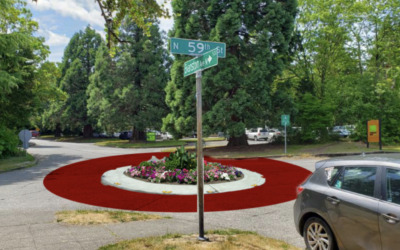Update: We have more information from the city about filing a claim for damages, and from City Light about how many people were affected and why they don’t directly contact customers about filing claims. Click on Read More below to find the info at the very end of the post.
Earlier: A Seattle City Light transmission line in Phinney Ridge failed on Feb. 17, taking out electricity to a number of homes in Phinney, Greenwood and the southeast end of Ballard, and causing damage to some houses’ electrical systems when the power surged.
The transmission line is on a pole on the east side of 3rd Avenue NW, just north of NW 67th Street.

The red line shows how the transmission line failure affected customers from the southeast end of Ballard north through parts of Phinney Ridge and Greenwood.
If your electrical system or electronics were damaged by that failure and surge, you can fill out an online City of Seattle Claim for Damages.
One neighbor tells us her home, across the street from the failed transmission line, incurred more than $1,800 in damage. She had to replace 10 GFI outlets (three of which were charred), and had two portable stereo systems burn out.
From her initial email to us:
The scary part is that SCL has chosen to not directly inform anybody in the affected area that this dangerous incident occurred (though apparently you would have gotten notice if you were on their “alert” notification list), but it will pay claims for damage that occurred as a result of the power surge. Some people may have what we had — GFI outlets frozen in the “on” position, or just completely not working. When the GFI is frozen “on”, it appears to work, but in the case of an electrical surge it will not switch off as it is intended to do. People may also not realize that some outlets are not working until months pass (especially external outlets), and by that time they may not be able to link the failure of the outlet to the power surge.
(Note: I left a very detailed message with a City Light spokesperson yesterday, with a long list of questions, and am waiting for a response. I will update this post when I hear back.) See the update at the very end of this post.
Here are some excerpts from SCL’s Transmission Line Incident Report:
On Tuesday, February 17, 2015, at approximately 1:45 pm, a ceramic power line insulator located in the Phinney/Greenwood neighborhood experienced a mechanical failure. This failure led to a series of events that resulted in disruption to service as well as electrical damage to personal property. City Light received 61 customer calls regarding the incident…To the best of our knowledge, this is the first and only failure of its kind to have occurred on City Light’s system.
…
The insulator was installed on a power pole located on the east side of 3rd Avenue NW, one pole north of NW 67th St. This pole has two levels of power lines: higher voltage transmission lines on the top; lower-voltage distribution lines beneath. Insulators support bare, energized conductors…
The insulator that failed consisted of a ceramic body with a metal base cemented to the bottom and a metal cap on the top. The cap supports a trunnion-type clamp that attaches to the conductor.
In this case, the end cap broke away from the ceramic body, allowing a bare, energized, 115 kilovolt (kV) line conductor to fall and make contact with a bare, energized, 26.4 kV line conductor situated below.
The 115 kV transmission line conductor briefly energized the 26.4 kV distribution line conductor to the higher voltage until the conductors were de-energized by protective relays designed to activate in such an instance…
Surge arresters, another piece of protective equipment in the system, absorbed the brunt of the surge, redirecting a portion safely to the ground system. Still, some of the voltage surge made its way down the distribution line through a transformer and into some of our customers’ home circuitry, causing electrical damage and outage.
…
A pole replacement project is planned for the area affected by this outage. As part of the project, all suspect insulators in the affected area will be replaced with the new polymer insulators. The project is set to begin May 2015, with an expected completion date of December 2015.
KIRO has a story on this incident, with an electrician explaining how such a power surge can affect electronics throughout the house.
If you were affected by this transmission line failure, please let us know in Comments or email us at [email protected].
Update Wednesday morning: Whitney tells us her claim for damages took about 4-6 weeks to process before receiving her check for damages related to the transmission line failure: One or two weeks for the city to send a letter saying it was reviewing her claim; another week for a letter to arrive saying they would be reimbursed but they had to sign a form saying they wouldn’t pursue legal action; then another week or so for the reimbursement check to arrive.
Update Wednesday afternoon: Here is more information from the City of Seattle Department of Finance and Administrative Services on filing a claim for damages.
What were the types of damages associated with the power outage?
Most of the claims have been for repairs to control boards of various electronic appliances or devices. For the most part, repair costs are being covered. However, if a homeowner’s claim is for the original purchase price to replace an item, depreciation is a factor (please see claims process explanation below).
Describe the claim process. Are there limitations in dollar amounts?
If someone feels the City was responsible for damages incurred, they can file a claim for damages, which must be submitted to the City Clerk’s Office within the applicable statute of limitations. Claims must be filed on the official Claim for Damages form.
The City of Seattle’s Risk Management division investigates and adjusts damage claims. Each claim is investigated individually by an adjustor. City departments affected by the claim are required to provide information as part of this investigation, as City Light did for this incident.
The City’s primary goal during the entire claims process is to be thorough and fair with how we handle the claims. Each claim is thoroughly investigated before it is settled because we have a responsibility to our ratepayers and taxpayers to make sure claim payments are justified.
When a claim investigation determines the City is at fault, we’ll settle the claim. If we’re wholly at fault, we pay the entire claim. If we’re partially at fault, we’ll pay the percentage of the claim equal to the percentage of fault. For example, if the investigation determines the City is 40 percent at fault, we’ll pay 40 percent of the claim.
If our investigation shows City systems did not contribute to the damage or if someone else is at fault, the claim will be denied. If the investigation determines another party is at fault, then the claimant can seek damages from that party.
The City is not generally liable for damage caused by power outages/surges, but the City considers each claim on a case-by-case basis. For example, the City would not pay claims for damage caused by outages/surges associated with windstorms or if another party caused the outage/surge (e.g., someone drives into a telephone pole). However, the circumstances of this particular situation were different than a typical outage/surge. Unique circumstances existed including the failure of certain City Light equipment, which then triggered an unusually high voltage surge. While it is not certain that those circumstances would warrant paying even a very similar claim, in this particular case, Risk Management has determined that these particular claims should be paid.
Please keep in mind that the City does not simply pay what is requested. Again, we have a responsibility to our ratepayers and taxpayers to ensure claims are valid and any payments are justified. Additionally, the City’s legal duty is to put the claimant back into the position they were just before the damage occurred; we will not reimburse for improvements beyond the condition of the property just before the damage occurred. For example, while a claimant with a irreparably damaged computer may submit an original receipt and request reimbursement of the purchase price of that computer, legally the City only owes the current value of the computer (i.e., the claimant does not get a brand new computer to replace his/her five-year-old computer, but would be compensated for the value of the computer just before the damage occurred).
How many have filed claims?
As of Friday, April 3, Risk Management has received 70 claims for damages.
Update Thursday afternoon: And here is more information from Seattle City Light on the incident.
Were there any damaged electrical services?
Approximately six that we are aware of at this time (things like damaged meters, meter sockets)
How many customers were affected?
There were 3800 customers who had a momentary outage and 85 customers who had a sustained power outage.
KIRO’s report says that City Light doesn’t directly contact customers regarding the claims process – why?
By ordinance, SCL is not typically responsible for customer losses that result from interruptions in service. We educate customers on protecting their equipment as a general rule. We do send letters out when we are conducting planned outages or doing some major infrastructure upgrade, but not after an outage occurs.




